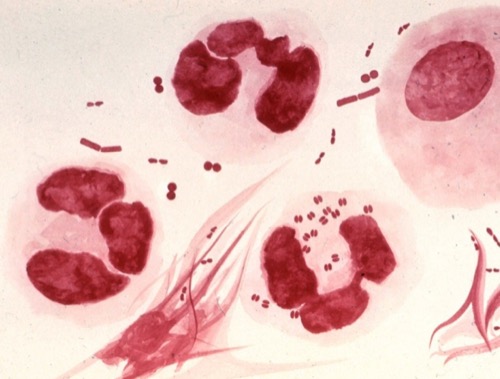You are here: Urology Textbook > Penis > Sexually transmitted diseases > Gonorrhea > Pathogen and symptoms
Gonorrhea: Pathogen and Symptoms of the gonococcal Urethritis
- Gonorrhea: Etiology, Signs and Symptoms
- Gonorrhea: Diagnosis and Treatment
Definition of Gonorrhea
Gonorrheal urethritis (GU) with purulent urethral discharge is a venereal disease caused by Neisseria gonorrhoeae. Gonorrhea is derived from an old Greek word meaning ‘flow of seed [semen]’.
Epidemiology of Gonorrhea
USA 114/100.000 new cases (in 2004), rising to nearly 200/100.000 (in 2021). Much lower figures in Europe, e.g., Germany 21/100.000 (in 2017).
Etiology of Gonorrhea
Bacterial pathogen:
Neisseria gonorrhoeae. Strictly aerobic. Unencapsulated.
Morphology of Gonococcus:
Gram-negative diplococci with a diameter of about 1 micron (coffee bean-shaped). Frequently intracellular in granulocytes [fig. gonorrhea (microscopy)].
 |
Virulence factors:
There are pili for the attachment to human epithelial cells and secretion of proteins as virulence factors: porins, IgA-ase, and penicillinase. The contact of gonococci leads to endocytosis and basal exocytosis. This results in an infection of the urethral lamina propria.
Transmission of gonorrhea:
Gonorrhoea is a mucus membrane infection due to vaginal, oral or anal sexual contact. The risk of infection per intercourse for men is around 17%. Rare transmission occurs through birth or as aerosol infection (conjunctivitis). Humans are the only reservoir for Neisseria gonorrhoeae.
Gonorrhea: Signs and Symptoms
Urethritis:
The incubation period is 3–10 days, with a significant variance depending on the bacterial strain. Typical symptoms are purulent discharge from the urethra, dysuria, pain in the urethra, and inguinal lymphadenopathy. The extent of the symptoms is variable; women experience fewer symptoms than men.
Extragenital Infections:
Proctitis or pharyngitis causes only minor or no symptoms; these are relevant bacterial reservoirs. Conjunctivitis (ophthalmia neonatorum) is typical for neonates [fig. neonatal conjunctivitis]. Seldom arthritis or gonococcal sepsis.
| Do you want to see the illustration? Please support this website with a Steady membership. In return, you will get access to all images and eliminate the advertisements. Please note: some medical illustrations in urology can be disturbing, shocking, or disgusting for non-specialists. Click here for more information. |
| Do you want to see the illustration? Please support this website with a Steady membership. In return, you will get access to all images and eliminate the advertisements. Please note: some medical illustrations in urology can be disturbing, shocking, or disgusting for non-specialists. Click here for more information. |
Complications of Gonorrhea
Complications in men:
Acute prostatitis, epididymitis, urethral strictures, and infertility.
Complications in women:
Bartholinitis, cervical endometritis, pelvic inflammatory disease, and infertility.
Fitz-Hugh-Curtis syndrome:
Fitz-Hugh-Curtis syndrome is an ascending pelvic inflammatory disease with peritoneal infection. Typical is right-sided abdominal pain due to infection of the hepatic peritoneum (perihepatitis).
Reiter syndrome:
Due to a mixed infection with Chlamydia, the Reiter syndrome can also be possible in gonorrhea. See also chapter non-gonococcal urethritis.
| STD | Index | Gonorrhea Treatment |
Index: 1–9 A B C D E F G H I J K L M N O P Q R S T U V W X Y Z
References
CDC Guidelines: gonococcal infections in adolescents and adults. https://www.cdc.gov/std/treatment-guidelines/gonorrhea-adults.htm
IUSTI, Unemo et ao.: European Guideline on the Diagnosis and Treatment of Gonorrhoea in Adults (2020). https://iusti.org/wp-content/uploads/2020/10/IUSTI-Gonorrhoea-2020.pdf
Luetkemeyer AF, Donnell D, Dombrowski JC, Cohen S, Grabow C, Brown CE, Malinski C, Perkins R, Nasser M, Lopez C, Vittinghoff E, Buchbinder SP, Scott H, Charlebois ED, Havlir DV, Soge OO, Celum C; DoxyPEP Study Team. Postexposure Doxycycline to Prevent Bacterial Sexually Transmitted Infections. N Engl J Med. 2023 Apr 6;388(14):1296-1306. doi: 10.1056/NEJMoa2211934.
Robert-Koch-Institut, “Gonorrhoe (Tripper): RKI Ratgeber,” 2023. [Online]. Available: https://www.rki.de/DE/Content/Infekt/EpidBull/Merkblaetter/Ratgeber_Gonorrhoe.html.
DDG, DSTIG, DGU, and RKI, “S3-Leitlinie: Management der Urethritis bei männlichen Jugendlichen und Erwachsenen.” [Online]. Available: https://register.awmf.org/assets/guidelines/013-099l_S3_Management-Urethritis-maennliche-Jugendliche-Erwachsene_2025-02.pdf
 Deutsche Version: Gonorrhoe: Erreger und Klinik gonorrhoischen Urethritis.
Deutsche Version: Gonorrhoe: Erreger und Klinik gonorrhoischen Urethritis.
Urology-Textbook.com – Choose the Ad-Free, Professional Resource
This website is designed for physicians and medical professionals. It presents diseases of the genital organs through detailed text and images. Some content may not be suitable for children or sensitive readers. Many illustrations are available exclusively to Steady members. Are you a physician and interested in supporting this project? Join Steady to unlock full access to all images and enjoy an ad-free experience. Try it free for 7 days—no obligation.
New release: The first edition of the Urology Textbook as an e-book—ideal for offline reading and quick reference. With over 1300 pages and hundreds of illustrations, it’s the perfect companion for residents and medical students. After your 7-day trial has ended, you will receive a download link for your exclusive e-book.